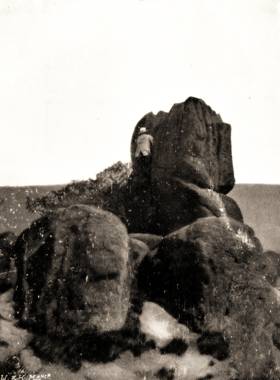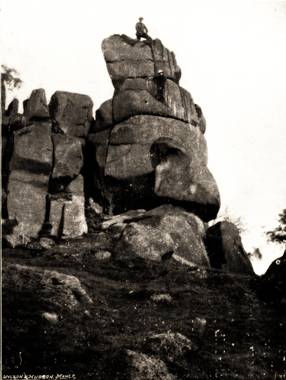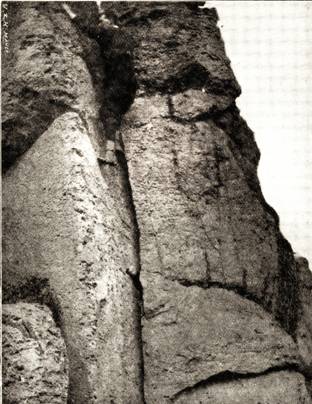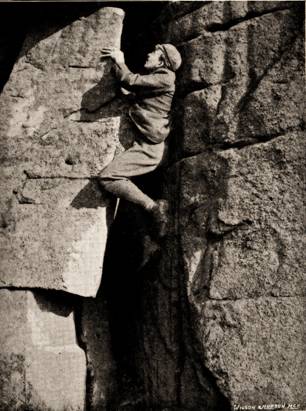Scrambling On Derbyshire Rocks
By Claude Barton
When on the way to Wasdale Head, some two years ago, it was suggested to me that a day’s practice might with advantage be had in Derbyshire, as there were rocks hard by which would afford good scrambling, and I was advised to spend my day on the Black Rocks and the Alport Stone.
I had heard of famous climbing men finding real difficulties on these rocks, and so on returning home was not ashamed to confess to having been fairly beaten by a Derbyshire crack.
In dealing with the Derbyshire rocks, it may be mentioned that they are of’ three formations. First the Millstone Grit, a rock of which many a man will have a practical reminder for several days after handling it. The Black Rocks, the Alport Stone, Robin Hoods Stride, and the Cratcliff Rocks are of Millstone Grit. Secondly, there is the Mountain Limestone of Dovedale, which does not lend itself particularly well to climbing; and, lastly, the Magnesian Limestone or Dolomitic formation found in the Brassington and Harboro’ Rocks.
Until last summer it was not convenient to repeat my visit to the district, but having a week to spare then I made tracks for Birchover, a small village near Matlock, which makes an excellent centre. I found my bicycle a somewhat useful auxiliary on the way. The first day was spent on the Rowtor and Bradley Rocks, which are in the village. On the former several good, though short scrambles can be had. In the afternoon a walk of fifteen minutes took me to the Cratcliff Rocks, where there is an excellent climb, called the Owl Gully, in which the jackdaws which crowd every niche and ledge strongly resent the presence of a stranger on what they evidently consider is their exclusive property. The only real difficulty the gully itself presents to the climber is the exit at the top, and this can be made by either wall, the left hand (looking up) being certainly the more difficult of the two finishes. Many other scrambles may be found on these rocks, and where the short, difficult bits are met they may be shirked at pleasure.
Close by is Robin Hood’s Stride, on which are climbs equal in severity to some of the choice nerve and muscle tests in the Lake District. The face climb of the Inaccessible Pinnacle, starting from the Boulder or Flying Buttress, and keeping straight up to the summit, is, in my opinion, quite equal to the Napes Needle by the ordinary way. Both pinnacles of the Stride are well worth a visit, as even on the ” Weasel”-the smaller of the two-there is a difficult side which calls for a not insignificant arm pull before one can land on the summit. On the “Inaccessible” there are three distinct routes, the first being tackled by mounting a small ledge, which is in itself a difficulty. Of the other two the long climb, which starts from the Boulder, has already been mentioned; above this a safe ledge is reached which runs half way round the Pinnacle. Traversing to the end of this ledge a start may be made for the last part of the climb which brings one up at the back of the Pinnacle. The finish of either of these climbs without a rope is a little bit sensational, and a slip would be far from pleasant. Fortunately the hand-holds are so safe and the rock itself so good that a slip would be almost inexcusable.
On the first opportunity a trip was made to the Black Rocks, about eight miles away from my centre, with the intention of wiping out the old score, but the little ” Cracklet” there certainly did not look any easier than when it repelled the attack two years before.
The climbing hereabouts is really good, all degrees of difficulty offering themselves in a very small compass. The climbs should be taken from right to left, starting with Harrison’s Chimney, which is certainly a tight fit, and then the Sand Gully, containing an awkward rounded boss of rock somewhat difficult to surmount. The holds in the latter are generally filled with sand and require some finding, but by working up the right side wall (looking up) sufficient friction can be got to enable one to overcome the pitch without them. The “Cracklet” is the next in order. Though short, this is exceedingly difficult, and is hardly justifiable without a rope. The crack is too narrow except for the hands and part of a toe, and the wrists must be wedged in and used as levers. The top of a convenient little tongue of rock makes the one and only resting-place for the feet, and about six feet above this the crack branches off abruptly to the left, and the legs have to be swung on to a small platform there. This little traverse is the
mauvais pas
of the climb. I consider that this “Cracklet” is equal in severity to Kern Knotts Crack on Great Gable, which, though difficult at the bottom, allows a feeling of security to be regained before the top is reached. The finish of the “Cracklet” consists of a small chimney which lands one on a grass ledge easy of access from another side. Another scramble on these rocks is up the Pine Tree Gully. On the occasion of a former visit there were serious obstacles there in the form of barbed wire, which had to be carefully removed prior to the ascent. There is also a little pinnacle near which is well worth ascending; and the Queen’s Parlour–at the extreme left of the Rocks-takes one down through a hole into the bowels of the earth, happily emerging at the bottom of the Crags.
Of all the Derbyshire scrambling, quite the most delightful is to be found on the Brassington and Harborough Rocks, which are marked on the large scale contour maps published by Bartholomew. They are of Dolomitic formation, and will be found very pleasant to grasp after the sharp and cutting millstone grit. The holds are magnificent, and the variety of climbing great. There is a good aréte climb on the Brassington Rocks, starting with a thin vertical crack which, were it not for an accommodating side wall, would prove very difficult. The jammed stone in the crack, though loose, may be relied upon. Above this is the top pile of rocks, in the face of which are two good chimneys, and round the corner to the left are several short climbs such as the cracklet and face climb depicted in the photographs here shown.
The Harborough Rocks, too, contain some good chimneys, and a fine little aréte. But more care is needed there than on the Brassington Rocks, as the more conspicuous holds are liable to break off at critical moments. These Dolomitic climbs are almost unknown even to local scramblers, and it is due to the friendly aid of Mr. Fred Marples, whose acquaintance with the district is extensive and peculiar, that these and other unheard-of practice grounds were introduced to me. I feel sure that anyone who visits them cannot fail to enjoy some really delightful scrambling, the sole equipment being a pair of well-nailed boots or even tennis shoes. I imagine that a trial with scarpetti on these rocks would prove interesting.[1]
One day was spent in futile attempts to find something climbable on the Mountain Limestone rocks of Dovedale. Formidable pinnacles certainly abound, but the holds are conspicuous by their absence, and the rock is hardly safe. I know two good men who went there last summer in search of climbing, but both came away without having found anything other than what was well within easy range of their powers. But there is plenty of scope about for enterprising men who care to try the ultra difficult and somewhat dangerous rocks.
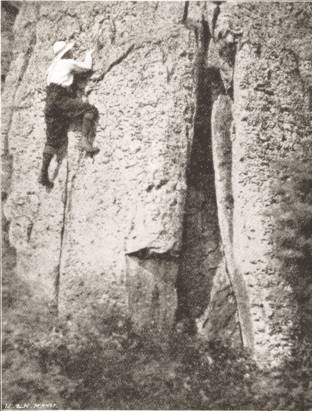
Other rocks visited during my stay were those on Stanton Moor, including the Audle Stone-or the “Two-Penny Loaf” as it is locally termed-just above Birchover, also Froggatt Edge, which entails a cycle ride of some twelve miles to “The Chequers” Inn. Here is a fine escarpment of rock, including a large pinnacle which, though tempting, appears likely to defy climbers’ efforts for some time to come. To the north of this lies Stanage Edge, and near by some good rocks called Mother Cop and Higgar Tor, and many other short bits worthy of being climbed. Altogether, anyone wishing for some really good practice scrambling cannot do better than visit some of the rocks here mentioned, and I feel sure that even if they spend a week as I did in this part of Derbyshire, and climb every day, they will neither exhaust the district nor fail to be pleased with the variety and-it may fairly be added-the severity of some of its climbs.
